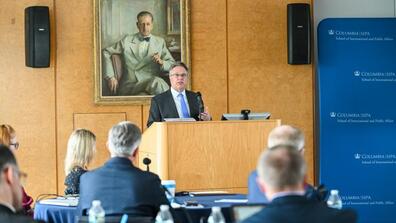Implementing Monetary Policy Post-Crisis
Wednesday, May 4, 2016 | Columbia University, International Affairs Building
The financial crisis has led to dramatic changes to the monetary policy implementation framework of number of central banks. Many countries have experienced very low interest rates for several years and some have pushed interest rates into negative territory. New regulations are having a profound effect on money markets.
As central bankers reflect on their monetary policy implementation framework in the years to come, what lessons can they draw from the crisis and the long period of very low rates since? What questions need to be answered to determine whether some of the new aspects of monetary policy implementation introduced since the crisis should be kept? What factors are most important in determining the “new normal” in monetary policy implementation?
This workshop brought together international experts in monetary policy design and implementation–academics, industry experts, as well as current and former central bankers–to reflect on key lessons from the post-crisis experience and brainstorm to develop a research agenda to inform future monetary policy implementation developments.
Agenda
Welcome: Patricia Mosser, Director, MPA Program in Economic Policy Management
Opening Remarks: Simon Potter, Federal Reserve Bank of New York
Lessons from the Crisis and Post-Crisis Experience
-
Chair: James Clouse, Federal Reserve Board
- Opening presentation: Marvin Goodfriend, Carnegie Mellon
- Benjamin Friedman, Harvard University (Discussant)
- Brian Sack, D.E Shaw and Co. (Discussant)
What is the future of balance sheet policies? How does the crisis experience inform the structure of central bank balance sheets in "normal" times?
- Chair: Lorie Logan, Federal Reserve Bank of New York
- Opening presentation: Paul Tucker, Harvard Kennedy School
- Masaaki Shirakawa, Aoyama Gakuin University (Discussant)
- Peter Stella, Stellar Consulting LLC (Discussant)
How Should Central Banks Steer Money Market Interest Rates?
- Chair: Jamie McAndrews, Federal Reserve Bank of New York
- Opening presentation: Francesco Papadia, Hellenic Financial Stability Fund
- Lou Crandall, Wrightson ICAP (Discussant)
- Todd Keister, Rutgers University (Discussant)
Wrap-up Observations
- Donald Kohn, Brookings Institution
Papers and Presentations
Conference Summary
Opening Remarks: Simon Potter, Federal Reserve Bank of New York
Opening presentation: Understanding central banking in light of the credit turmoil
Marvin Goodfriend, Tepper School, Carnegie Mellon University
Discussion: Implementing monetary policy post-crisis: What have we learned? What do we need to know?
Benjamin Friedman, Harvard University
Discussion: Lessons from the crisis and post-crisis experience
Brian Sack, The D.E. Shaw Group
Opening paper: The political economy of central bank balance sheet management
Paul Tucker, Harvard Kennedy School
Discussion: Comments on Paul Tucker’s presentation
Masaaki Shirakawa, Aoyama Gakuin University
Discussion: The political economy of central bank balance sheet management
Peter Stella, Stellar Consulting LLC
Opening presentation: How should central banks steer money market interest rates?
Francesco Papadia, Hellenic Financial Stability Fund
Discussion: How should central banks steer money market interest rates?
Todd Keister, Rutgers University
Workshop discussion: How should central banks steer money market rates?
Lou Crandall, Wrightson ICAP
Conference summary remarks
Donald Kohn, Brookings Institution
Organizers & Sponsors
Patricia Mosser, Director, MPA Program in Economic Policy Management
Julie Remache, Federal Reserve Bank of New York
Antoine Martin, Federal Reserve Bank of New York
Columbia University, School of International and Public Affairs
Federal Reserve Bank of New York
